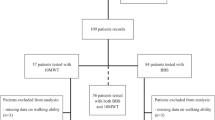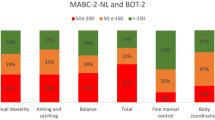Abstract
Purpose
The study aims were to determine the prevalence of balance impairments in adult survivors of pediatric central nervous system (CNS) tumors, and to identify predictors of and limitations associated with balance impairments.
Methods
Participants were adult survivors (N = 329) of pediatric CNS tumors. Balance was considered impaired among those with composite scores < 70 on the sensory organization test. Potential predictors of impaired balance were evaluated with generalized linear regression. Multivariable logistic regression was used to evaluate associations between balance impairment and function.
Results
Balance impairment was observed in 48% of survivors, and associated with infratentorial tumor location (OR = 4.0, 95% CI, 2.0–7.6), shunt placement (OR = 3.5, 95% CI, 1.8–6.7), increased body fat percentage (OR = 1.1, 95% CI, 1.0–1.1), hearing loss (OR = 11.1, 95% CI, 5.6–22.2), flexibility limitations (OR = 2.0, 95% CI, 1.0–3.9), peripheral neuropathy (OR = 2.4, 95% CI, 1.2–4.5), and cognitive deficits (OR = 2.2, 95% CI, 1.1–4.7). In adjusted models, impaired balance was associated with limitations in overall physical performance (OR = 3.6, 95% CI, 2.0–6.3), mobility (OR = 2.6, 95% CI, 1.5–4.4), diminished walking endurance (OR = 2.9, 95% CI, 1.7–5.0), and non-independent living (OR = 2.0, 95% CI, 1.0–4.3).
Conclusions
Nearly half of adult survivors of pediatric CNS tumors have impaired balance, which is associated with mobility and physical performance limitations. Interventions to address the complex needs of this population should be prioritized.
Implications for Cancer Survivors
Survivors with identified risk factors should be closely evaluated for presence of balance impairment. Interventions tailored to improve balance also can positively affect function and mobility in survivors.

Similar content being viewed by others
References
Horak FB. Postural orientation and equilibrium: what do we need to know about neural control of balance to prevent falls? Age and ageing. 2006;35(suppl_2):ii7-ii11.
de CdSC S, Boffino CC, Ramos RT, Tanaka C. Development of postural control and maturation of sensory systems in children of different ages a cross-sectional study. Brazilian journal of physical therapy. 2018;22(1):70–6.
Peterson ML, Christou E, Rosengren KS. Children achieve adult-like sensory integration during stance at 12-years-old. Gait & posture. 2006;23(4):455–63.
Abrahamova D, Hlavačka F. Age-related changes of human balance during quiet stance. Physiological Research. 2008;57(6).
Ding D, Allman BL, Salvi R. Ototoxic characteristics of platinum antitumor drugs. Anat Rec Adv Integr Anat Evol Biol. 2012;295(11):1851–67.
Zajączkowska R, Kocot-Kępska M, Leppert W, Wrzosek A, Mika J, Wordliczek J. Mechanisms of chemotherapy-induced peripheral neuropathy. Int J Mol Sci. 2019;20(6):1451.
Grisold W, Cavaletti G, Windebank AJ. Peripheral neuropathies from chemotherapeutics and targeted agents: diagnosis, treatment, and prevention. Neuro-oncology. 2012;14(suppl_4):iv45–54.
Packer RJ, Gurney JG, Punyko JA, Donaldson SS, Inskip PD, Stovall M, et al. Long-term neurologic and neurosensory sequelae in adult survivors of a childhood brain tumor: childhood cancer survivor study. Journal of clinical oncology : official journal of the American Society of Clinical Oncology. 2003;21(17):3255–61. https://doi.org/10.1200/jco.2003.01.202.
Ness KK, Morris EB, Nolan VG, Howell CR, Gilchrist LS, Stovall M, et al. Physical performance limitations among adult survivors of childhood brain tumors. Cancer. 2010;116(12):3034–44. https://doi.org/10.1002/cncr.25051.
Turner CD, Rey-Casserly C, Liptak CC, Chordas C. Late effects of therapy for pediatric brain tumor survivors. J Child Neurol. 2009;24(11):1455–63.
Sontgerath R, Eckert K. Impairments of lower extremity muscle strength and balance in childhood cancer patients and survivors: a systematic review. Pediatr Hematol Oncol. 2015;32(8):585–612. https://doi.org/10.3109/08880018.2015.1079756.
Turner M, Gagnon D, Lagace M, Gagnon I. Effect of treatment for paediatric cancers on balance: what do we know? A review of the evidence. European journal of cancer care. 2013;22(1):3–11. https://doi.org/10.1111/ecc.12019.
Hudson MM, Ness KK, Nolan VG, Armstrong GT, Green DM, Morris EB, et al. Prospective medical assessment of adults surviving childhood cancer: study design, cohort characteristics, and feasibility of the St. Jude Lifetime cohort study. Pediatr Blood Cancer. 2011;56(5):825–36.
Hudson MM, Ehrhardt MJ, Bhakta N, Baassiri M, Eissa H, Chemaitilly W, et al. Approach for classification and severity grading of long-term and late-onset health events among childhood cancer survivors in the St. Jude Lifetime cohort. Cancer Epidemiol Biomark Prev. 2017;26(5):666–74. https://doi.org/10.1158/1055-9965.epi-16-0812.
Nashner LM, Peters JF. Dynamic posturography in the diagnosis and management of dizziness and balance disorders. Neurol Clin. 1990.
Pedalini MEB, Cruz OLM, Bittar RSM, Lorenzi MC, Grasel SS. Sensory organization test in elderly patients with and without vestibular dysfunction. Acta Otolaryngol. 2009;129(9):962–5.
Landers MR, Backlund A, Davenport J, Fortune J, Schuerman S, Altenburger P. Postural instability in idiopathic Parkinson’s disease: discriminating fallers from nonfallers based on standardized clinical measures. J Neurol Phys Ther. 2008;32(2):56–61.
Ness KK, Hudson MM, Pui CH, Green DM, Krull KR, Huang TT, et al. Neuromuscular impairments in adult survivors of childhood acute lymphoblastic leukemia: associations with physical performance and chemotherapy doses. Cancer. 2012;118(3):828–38. https://doi.org/10.1002/cncr.26337.
Jacobson GP, Newman CW. Kartush JM. Thomson Demar Learning: Handbook of balance function testing; 1997.
Wampler MA, Miaskowski C, Hamel K, Byl N, Rugo H, Topp KS. The modified total neuropathy score: a clinically feasible and valid measure of taxane-induced peripheral neuropathy in women with breast cancer. J Support Oncol. 2006;4(8):W9–W16.
Varedi M, Lu L, Howell CR, Partin RE, Hudson MM, Pui C-H, et al. Peripheral neuropathy, sensory processing, and balance in survivors of acute lymphoblastic leukemia. J Clin Oncol. 2018;36(22):2315–22. https://doi.org/10.1200/jco.2017.76.7871.
Lavoie Smith EM, Li L, Chiang C, Thomas K, Hutchinson RJ, Wells EM, et al. Patterns and severity of vincristine-induced peripheral neuropathy in children with acute lymphoblastic leukemia. Journal of the peripheral nervous system : JPNS. 2015;20(1):37–46. https://doi.org/10.1111/jns.12114.
Harbo T, Brincks J, Andersen H. Maximal isokinetic and isometric muscle strength of major muscle groups related to age, body mass, height, and sex in 178 healthy subjects. Eur J Appl Physiol. 2012;112(1):267–75. https://doi.org/10.1007/s00421-011-1975-3.
Shephard RJ, Berridge M, Montelpare W. On the generality of the “sit and reach” test: an analysis of flexibility data for an aging population. Res Q Exerc Sport. 1990;61(4):326–30. https://doi.org/10.1080/02701367.1990.10607495.
Boone DC, Azen SP, Lin CM, Spence C, Baron C, Lee L. Reliability of goniometric measurements. Phys Ther. 1978;58(11):1355–60.
McCrimmon AW, Smith AD. Review of the Wechsler Abbreviated Scale of Intelligence (WASI-II). Los Angeles: Sage Publications; 2013.
Reuben DB, Siu AL. An objective measure of physical function of elderly outpatients. The physical performance test. J Am Geriatr Soc. 1990;38(10):1105–12.
Bohannon RW. Reference values for the timed up and go test: a descriptive meta-analysis. J Geriatr Phys Ther. 2006;29(2):64–8.
Enright PL. The six-minute walk test. Respir Care. 2003;48(8):783–5.
Enright PL, Sherrill DL. Reference equations for the six-minute walk in healthy adults. Am J Respir Crit Care Med. 1998;158(5):1384–7.
Ware JE Jr. SF-36 health survey update. Spine. 2000;25(24):3130–9.
Friedman J. Regularization paths for generalized linear models via coordinate descent. J Stat Softw. 2010;33(1):1–22.
Syczewska M, Dembowska-Baginska B, Perek-Polnik M, Perek D. Functional status of children after treatment for a malignant tumour of the CNS: a preliminary report. Gait Posture. 2006;23(2):206–10. https://doi.org/10.1016/j.gaitpost.2005.02.001.
Piscione PJ, Bouffet E, Mabbott DJ, Shams I, Kulkarni AV. Physical functioning in pediatric survivors of childhood posterior fossa brain tumors. Neuro-oncology. 2013;16(1):147–55.
Wilke M, Dechent P, Bähr M. Sarcoidosis manifestion centered on the thalamic pulvinar leading to persistent astasia. Movement disorders clinical practice. 2017;4(6):898–900.
Rüb U, Del Turco D, Del Tredici K, De Vos R, Brunt E, Reifenberger G, et al. Thalamic involvement in a spinocerebellar ataxia type 2 (SCA2) and a spinocerebellar ataxia type 3 (SCA3) patient, and its clinical relevance. Brain. 2003;126(10):2257–72.
Ferro JM, Bravo-Marques J, Castro-Caldas A, Antunes L. Crossed optic ataxia: possible role of the dorsal splenium. J Neurol Neurosurg Psychiatry. 1983;46(6):533–9.
Pisella L, Sergio L, Blangero A, Torchin H, Vighetto A, Rossetti Y. Optic ataxia and the function of the dorsal stream: contributions to perception and action. Neuropsychologia. 2009;47(14):3033–44.
Eickhoff SB, Weiss PH, Amunts K, Fink GR, Zilles K. Identifying human parieto-insular vestibular cortex using fMRI and cytoarchitectonic mapping. Hum Brain Mapp. 2006;27(7):611–21.
Nikaido Y, Akisue T, Urakami H, Kajimoto Y, Kuroda K, Kawami Y, et al. Postural control before and after cerebrospinal fluid shunt surgery in idiopathic normal pressure hydrocephalus. Clin Neurol Neurosurg. 2018;172:46–50. https://doi.org/10.1016/j.clineuro.2018.06.032.
Satzer D, Guillaume DJ. Hearing loss in hydrocephalus: a review, with focus on mechanisms. Neurosurg Rev. 2016;39(1):13–24; discussion 5. https://doi.org/10.1007/s10143-015-0650-2.
Zerf M. Body composition versus body fat percentage as predictors of posture/balance control mobility and stability among football players under 21 years. Physical education of students. 2017;21(2):96–102.
Alonso AC, Mochizuki L, Silva Luna NM, Ayama S, Canonica AC, Greve JM. Relation between the sensory and anthropometric variables in the quiet standing postural control: is the inverted pendulum important for the static balance control? Biomed Res Int. 2015;2015:1–5.
Mainenti MRM, Rodrigues ÉC, JFd O, AdS F, Dias CM, ALdS S. Adiposity and postural balance control: correlations between bioelectrical impedance and stabilometric signals in elderly Brazilian women. Clinics. 2011;66(9):1513–8.
Schoch B, Konczak J, Dimitrova A, Gizewski ER, Wieland R, Timmann D. Impact of surgery and adjuvant therapy on balance function in children and adolescents with cerebellar tumors. Neuropediatrics. 2006;37(6):350–8. https://doi.org/10.1055/s-2007-964904.
Konczak J, Schoch B, Dimitrova A, Gizewski E, Timmann D. Functional recovery of children and adolescents after cerebellar tumour resection. Brain. 2005;128(6):1428–41. https://doi.org/10.1093/brain/awh385.
Omoti AE, Omoti CE. Ocular toxicity of systemic anticancer chemotherapy. J Pharm Pract. 2006;4(2):55.
Cao Y, Summerfield C, Park H, Giordano BL, Kayser C. Causal inference in the multisensory brain. Neuron. 2019;102(5):1076–1087. e8.
Peterka RJ. Sensorimotor integration in human postural control. J Neurophysiol. 2002;88(3):1097–118. https://doi.org/10.1152/jn.2002.88.3.1097.
Syczewska M, Dembowska-Baginska B, Perek-Polnik M, Kalinowska M, Perek D. Postural sway in children and young adults, survivors of CNS tumours. Advances in medical sciences. 2008;53(2):256–62. https://doi.org/10.2478/v10039-008-0031-y.
Brinkman TM, Li Z, Neglia JP, Gajjar A, Klosky JL, Allgood R, et al. Restricted access to the environment and quality of life in adult survivors of childhood brain tumors. J Neuro-Oncol. 2013;111(2):195–203. https://doi.org/10.1007/s11060-012-1001-6.
Brinkman TM, Ness KK, Li Z, Huang I-C, Krull KR, Gajjar A et al. Attainment of functional and social independence in adult survivors of pediatric CNS tumors: a report from the St Jude Lifetime cohort study. Journal of Clinical Oncology.0(0):JCO.2018.77.9454. doi:https://doi.org/10.1200/jco.2018.77.9454.
Duregon F, Vendramin B, Bullo V, Gobbo S, Cugusi L, Di Blasio A, et al. Effects of exercise on cancer patients suffering chemotherapy-induced peripheral neuropathy undergoing treatment: a systematic review. Crit Rev Oncol Hematol. 2018;121:90–100.
McCrary JM, Goldstein D, Sandler CX, Barry BK, Marthick M, Timmins HC, et al. Exercise-based rehabilitation for cancer survivors with chemotherapy-induced peripheral neuropathy. Support Care Cancer. 2019;27(10):3849–57.
Reynolds CR, Suzuki LA. Bias in psychological assessment: an empirical review and recommendations. In: Handbook of psychology. second ed; 2012.
Ness KK, Krull KR, Jones KE, Mulrooney DA, Armstrong GT, Green DM, et al. Physiologic frailty as a sign of accelerated aging among adult survivors of childhood cancer: a report from the St Jude Lifetime cohort study. J Clin Oncol. 2013;31(36):4496–503. https://doi.org/10.1200/jco.2013.52.2268.
Ness KK, Armstrong GT, Kundu M, Wilson CL, Tchkonia T, Kirkland JL. Frailty in childhood cancer survivors. Cancer. 2015;121(10):1540–7. https://doi.org/10.1002/cncr.29211.
Funding
Support was provided by the National Cancer Institute Grants No. CA195547 (M.H.) and CA21765 (C. Roberts), and the American Lebanese Syrian Associated Charities.
Author information
Authors and Affiliations
Contributions
L.R., M.H., T.B., G.A., R.K., and K.N. were the principal investigators of the RCTs for which the data were originally collected and were involved in data collection. In addition, R.P. was involved in data collection. All authors were involved in the conceptualization of this study. M.V., L.L., and K.N. performed the statistical analysis. M.V., N.P., E.C., R.M., D.P., and K.N. wrote the first draft of the manuscript. All authors were involved in the revision of the manuscript and have read and approved the final version.
Corresponding author
Ethics declarations
Conflict of interest
The authors declare that they have no conflict of interest.
Additional information
Publisher’s note
Springer Nature remains neutral with regard to jurisdictional claims in published maps and institutional affiliations.
Rights and permissions
About this article
Cite this article
Varedi, M., Lu, L., Phillips, N.S. et al. Balance impairment in survivors of pediatric brain cancers: risk factors and associated physical limitations. J Cancer Surviv 15, 311–324 (2021). https://doi.org/10.1007/s11764-020-00932-5
Received:
Accepted:
Published:
Issue Date:
DOI: https://doi.org/10.1007/s11764-020-00932-5




